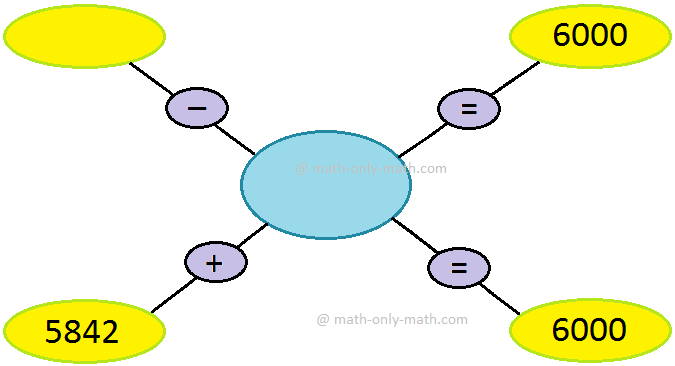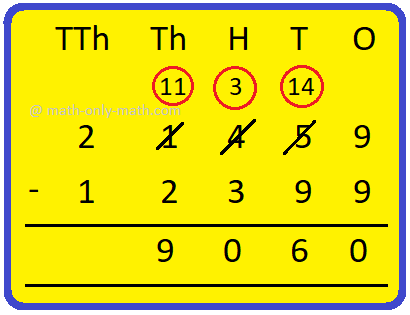Inverse Trigonometric Functions
We will discuss here about Inverse trigonometric Functions or inverse circular functions.
The inverse of a function f: A → B exists if and only if f is one-one onto (i.e., bijection) and given by
f(x) = y⇔ f\(^{-1}\) (y) = x.
Consider the sine function. Clearly, sin: R → R given by sin θ = x for all θ ∈ R is a many-one into function. So, its inverse does not exist. If we restrict its domain to the interval [- \(\frac{π}{2}\), \(\frac{π}{2}\)] then we may have infinitely many values of the angle θ which satisfy the equation sin θ = x i.e., sine of any one of these angles is equal to x. Here angle θ is represented as sin\(^{-1}\)x which is read as sine inverse x or arc sin x. Therefore, the symbol sin\(^{-1}\)x represents an angle and the sine of this angle has the value x.
Note the difference between sin\(^{-1}\)x
and sin θ: sin\(^{-1}\)x represents an
angle while sin θ represents a
pure number; again, for a given value of x (- 1 ≤ x ≤ 1) we may have infinitely many vales of sin\(^{-1}\)x
i.e., sin\(^{-1}\)x is a multiple-valued
function; but a given value of θ gives a definite finite value of sin θ i.e.,
sin θ is a single-valued function. Thus, if x is a real number lying
between -1 and 1, then sin\(^{-1}\) x is an angle between - \(\frac{π}{2}\)
and \(\frac{π}{2}\) whose sine is x i.e.,
sin\(^{-1}\)x = θ
⇔ x = sin θ, where - \(\frac{π}{2}\) ≤ x ≤ \(\frac{π}{2}\) and - 1 ≤ x ≤ 1.
In the above discussion we have restricted the sine function to the interval [- \(\frac{π}{2}\), \(\frac{π}{2}\)] to ake it a bijection. In fact we restrict the domain of sin θ to any of the interval [- \(\frac{π}{2}\), \(\frac{π}{2}\)], [\(\frac{3π}{2}\), \(\frac{5π}{2}\)], [- \(\frac{5π}{2}\), -\(\frac{3π}{2}\)] etc. sin θ is one-one onto function with range [-1, 1]. We therefore conclude that each of these intervals we can define the inverse of sine function. Thus sin\(^{-1}\)x is a function with domain [-1, 1] = {x ∈ R: - 1 ≤ x ≤ 1} and range [- \(\frac{π}{2}\), \(\frac{π}{2}\)] or [\(\frac{3π}{2}\), \(\frac{5π}{2}\)] or [- \(\frac{5π}{2}\), -\(\frac{3π}{2}\)] and so on.
Similarly, if cos θ = x (- 1 ≤ x ≤ 1 ) then θ = cos\(^{-1}\)x i.e., cos\(^{-1}\)x (cos-inverse x) represents an angle and the cosine of this angle is equal to x. We have similar significances of the angles tan\(^{-1}\)x (tan-inverse x), cot\(^{-1}\)x (cot-inverse x), sec\(^{-1}\)x (sec-inverse x) and csc\(^{-1}\)x (csc-inverse x).
Therefore, if sin θ = x (- 1 ≤ x ≤ 1) then θ = sin\(^{-1}\)x;
if cos θ = x (- 1 ≤ x ≤ 1) then θ = cos\(^{-1}\)x ;
if tan θ = x (- ∞ < x < ∞) then θ = tan\(^{-1}\)x ;
if csc θ = x (I x I ≥ 1) then θ = csc\(^{-1}\)x.
if sec θ = x (I x I ≥ 1) then θ = sec\(^{-1}\)x ; and
if cot θ = x (- ∞ < x < ∞) then θ = cot\(^{-1}\)x ;
Conversely, sin\(^{-1}\)x = θ ⇒ sin θ = x;
cos\(^{-1}\)x = θ ⇒ cos θ = x
tan\(^{-1}\)x = θ ⇒ tan θ = x
csc\(^{-1}\)x = θ ⇒ csc θ = x
cot\(^{-1}\)x = θ ⇒ cot θ = x
The trigonometrical functions sin\(^{-1}\)x, cos\(^{-1}\)x, tan\(^{-1}\)x, cot\(^{-1}\)x, sec\(^{-1}\)x and csc\(^{-1}\)x are called Inverse Circular Functions.
Note: It should be noted that sin\(^{-1}\)x is not equal to (sin x)\(^{-1}\). Also noted that (sin x)\(^{-1}\)is an angle whose sin is x. Remember that sin\(^{-1}\)x is a circular function but (sin x )\(^{-1}\) is the reciprocal of sin x i.e., (sin x)\(^{-1}\) = 1/sin x and it represents a pure number.
● Inverse Trigonometric Functions
- General and Principal Values of sin\(^{-1}\) x
- General and Principal Values of cos\(^{-1}\) x
- General and Principal Values of tan\(^{-1}\) x
- General and Principal Values of csc\(^{-1}\) x
- General and Principal Values of sec\(^{-1}\) x
- General and Principal Values of cot\(^{-1}\) x
- Principal Values of Inverse Trigonometric Functions
- General Values of Inverse Trigonometric Functions
- arcsin(x) + arccos(x) = \(\frac{π}{2}\)
- arctan(x) + arccot(x) = \(\frac{π}{2}\)
- arctan(x) + arctan(y) = arctan(\(\frac{x + y}{1 - xy}\))
- arctan(x) - arctan(y) = arctan(\(\frac{x - y}{1 + xy}\))
- arctan(x) + arctan(y) + arctan(z)= arctan\(\frac{x + y + z – xyz}{1 – xy – yz – zx}\)
- arccot(x) + arccot(y) = arccot(\(\frac{xy - 1}{y + x}\))
- arccot(x) - arccot(y) = arccot(\(\frac{xy + 1}{y - x}\))
- arcsin(x) + arcsin(y) = arcsin(x \(\sqrt{1 - y^{2}}\) + y\(\sqrt{1 - x^{2}}\))
- arcsin (x) - arcsin(y) = arcsin (x \(\sqrt{1 - y^{2}}\) - y\(\sqrt{1 - x^{2}}\))
- arccos (x) + arccos(y) = arccos(xy - \(\sqrt{1 - x^{2}}\)\(\sqrt{1 - y^{2}}\))
- arccos(x) - arccos(y) = arccos(xy + \(\sqrt{1 - x^{2}}\)\(\sqrt{1 - y^{2}}\))
- 2 arcsin(x) = arcsin(2x\(\sqrt{1 - x^{2}}\))
- 2 arccos(x) = arccos(2x\(^{2}\) - 1)
- 2 arctan(x) = arctan(\(\frac{2x}{1 - x^{2}}\)) = arcsin(\(\frac{2x}{1 + x^{2}}\)) = arccos(\(\frac{1 - x^{2}}{1 + x^{2}}\))
- 3 arcsin(x) = arcsin(3x - 4x\(^{3}\))
- 3 arccos(x) = arccos(4x\(^{3}\) - 3x)
- 3 arctan(x) = arctan(\(\frac{3x - x^{3}}{1 - 3 x^{2}}\))
- Inverse Trigonometric Function Formula
- Principal Values of Inverse Trigonometric Functions
- Problems on Inverse Trigonometric Function
11 and 12 Grade Math
From General solution of Trigonometric Equation to HOME PAGE
Didn't find what you were looking for? Or want to know more information about Math Only Math. Use this Google Search to find what you need.
Recent Articles
-
Multiplication Table | Learn Tables from 0 – 25 | Multiplication Table
Jan 14, 25 11:09 PM
In math multiplication table we will learn the tables from 0 – 25. These multiplication tables help the students to learn the essential multiplication facts. Multiplication tables are very important f… -
3rd Grade Math Worksheets |3rd Grade Math Sheets|3rd Grade Math Lesson
Jan 14, 25 11:02 PM
3rd grade math worksheets is carefully planned and thoughtfully presented on mathematics for the students. Teachers and parents can also follow the worksheets to guide the students. -
3rd Grade Subtraction Worksheet | 3-Digit Subtraction Worksheets | Ans
Jan 14, 25 01:57 PM
In 3th Grade Addition Worksheet we will solve how to subtract 3-digit numbers by expansion, subtraction of 3-digit numbers without regrouping, subtraction of 3-digit numbers with regrouping, propertie… -
Facts about Subtraction | Subtraction of Small Numbers|Solved Examples
Jan 14, 25 12:29 AM
The operation to finding the difference between two numbers is called subtraction. Let us know some facts about subtraction which will help us to learn subtraction of large numbers. 1. Subtraction wit… -
Word Problems on Subtraction |Worksheet on Subtraction Word Problems |
Jan 14, 25 12:21 AM
In word problems on subtraction we need to read the question carefully and understand what we need to find out. We know, in subtraction the larger number from which we subtract the other number (the s…





New! Comments
Have your say about what you just read! Leave me a comment in the box below. Ask a Question or Answer a Question.